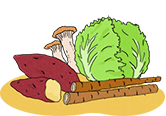The surprising facts about dietary fiber
The classifications and features of dietary fiber
Broadly, dietary fiber is divided into two types, each with different characteristics: soluble fiber and insoluble fiber.
Insoluble dietary fiber
A feature of insoluble fiber is the long, rough, threadlike filaments found in vegetables and other foods.
- Insoluble fiber-rich foods
- In addition to grains, vegetables, and legumes, insoluble fiber is also found in the shells of shrimp and crabs.
- Features of insoluble fiber
-
- High water retention
Insoluble fiber swells up as it absorbs water in the stomach and intestines, stimulating the intestine, activating peristalsis, and promoting bowel movements. - Fibrous, honeycombed, and spongy
Insoluble fiber requires chewing well when eaten, helping prevent overeating, strengthening the jaw, and improving teeth alignment. - Fermentability
When insoluble fiber ferments and decomposes in the large intestine, bifidobacteria and other gut flora increase, improving the intestinal environment, which has an intestinal regulation effect. Generally, insoluble fiber is less fermentable than soluble fiber.
- High water retention
Soluble dietary fiber
Soluble fiber can have sticky or non-sticky texture.
- Soluble fiber-rich foods
- Soluble fiber is found in foods such as kelp, wakame seaweed, konjac food, fruits, and taro potatoes. The raw ingredient of konjac foods dissolves in water, but solid konnyaku does not.
- Features of water-soluble fiber
-
- Viscosity
Food containing soluble fiber travels through the stomach and intestines slowly because of its viscosity, reducing hunger and helping prevent overeating. It suppresses spikes in blood sugar after eating by slowing the absorption of sugar. - Adsorptive property
Soluble fiber adsorbs bile acid and cholesterol, aiding their excretion from the body. - Fermentability
When soluble fiber ferments and decomposes in the large intestine, bifidobacteria and other good bacterium increase, improving the intestinal environment, which has an intestinal healing effect.
- Viscosity
Soluble fibers frequently used as a food ingredient
- Indigestible dextrin
Dietary fiber made from starch as a supplement that is added to foods to prevent fiber deficiency. This is the the most frequently used form of dietary fiber, is very safe and is approved for use in 'food for specified healthuse' by the Consumer Affairs Agency (Japan). - Polydextrose
Dietary fiber made by mixing glucose, sorbitol and citric acid. It has the effect of increasing blood glucose levels and reducing cholesterol.
It is widely known that dietary fiber is good for maintaining your health, but it also has a number of other benefits.






